- Average monthly contract: $5,458 across all respondents. Most retainers fall under $10K per month, with half priced below $5K.
- Average cost per link (CPL): $597. Costs vary widely by service type, ranging from $150 for guest posting to $800 for large hero campaigns.
- 1 in 3 respondents don’t know their CPL, a sign that digital PR is shifting away from deliverable-based pricing toward broader visibility metrics.
- Agencies charge about 50% more than freelancers on average ($6,357 vs. $4,200 monthly) due to larger teams, creative production, and reporting overhead.
- Regional divide: U.K. practitioners focus on earned and creative PR (hero content, newsjacking), while U.S. respondents lean toward journalist requests and guest posting.
- Half of the respondents guarantee links, but guarantees are far more common in the U.S. and among guest-posting services.
One of the questions I get asked frequently is how much digital PR costs. However, the answer is always a lot more nuanced than people are led to believe.
Although digital PR is trying to distance itself from a focus on “links,” the standard metric that most clients or stakeholders gravitate towards is cost per link.
We have our link-building pricing breakdown, but I wanted to dig in further.
So, I surveyed ~70 agency leaders and freelancers/consultants who offer digital PR in the space to develop our 2025 cost of digital PR report.
A few notes on the demographics
I wanted to get a balance, so I sought out a mix of half agencies and half freelancers/consultants.
A larger proportion of responses comes from the UK (54%), followed by the US (23%).
Although I asked, no respondents seemed to focus on any particular industry, so the mix is broad.
In this post, I will outline the key costs, and then we’ll break down the findings by several different metrics.
The “Digital PR” Misnomer
Before we get into all of this, I need to clear something up.
I based most of my survey outreach on LinkedIn and website services. So, when a site or profile says it provides “Digital PR” services, I reach out to them.
What I’m finding, however, is that many people are now grouping “guest posting” in with digital PR:
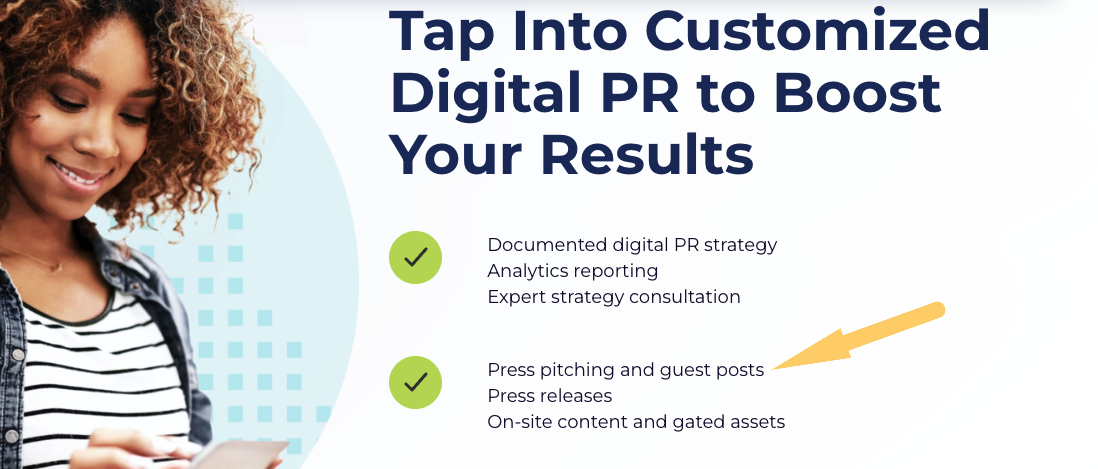
Here’s another example:
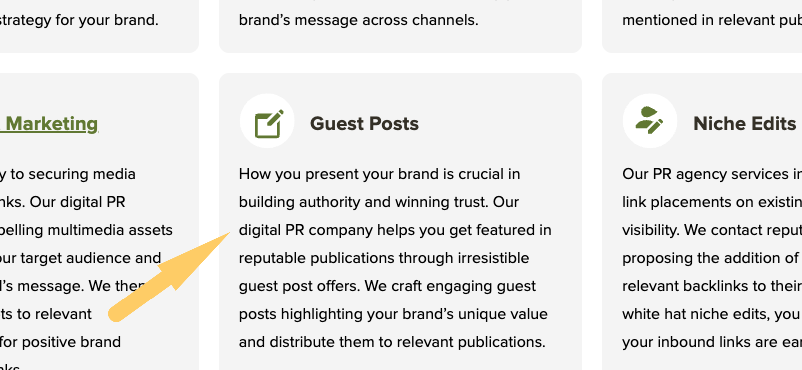
This is actually skewing some of the data that we are seeing—especially in the US.
Really, when I say digital PR, I mean earned media through pitching journalists from top-tier industry news publications for coverage.
That said, not all guest posting is the spammy, paid kind that you see in those shared guest posting spreadsheets.
Some marketers use guest posting as an opportunity for thought leadership. Other sites accept guest authors to help build out their content and showcase third-party expertise and experience.
But to me, that isn’t quite what I think digital PR is based on our definition. You’ll see that this has an outsized impact on some of our results.
I also wanted to mention that reactive PR/proactive PR can sometimes get grouped with responding to journalist requests. For what it’s worth, an overwhelming majority of digital PR professionals that I speak to tend to call reactive its own strategy.
Average Monthly Contract Size for Digital PR
The average monthly contract size across all respondents is approximately $5,458.
In general, contracts rarely seem to exceed $10k per month.
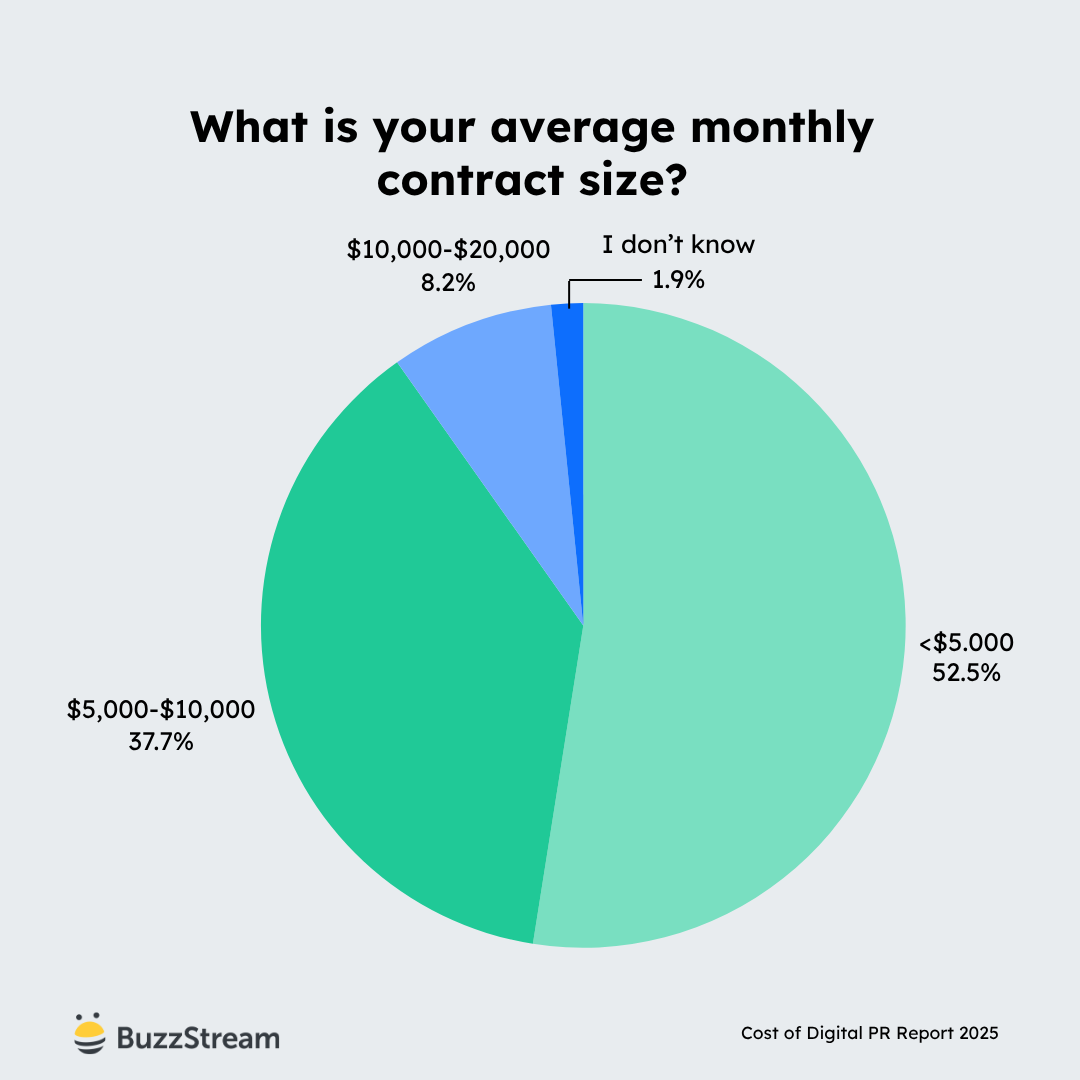
As you can see, about half of the digital PR monthly contracts are under $5,000 (52.5%), followed by 38% in the $ 5,000- $10,000 range.
As you’ll see, costs tend to scale based on creative effort.
Let’s look at the cost per link next.
Cost Per Link for Digital PR
The average cost per link for digital PR across all respondents is $597.
Although cost per link is an outdated PR metric, it remains one of the most common ways to report and sell any type of service that involves links.
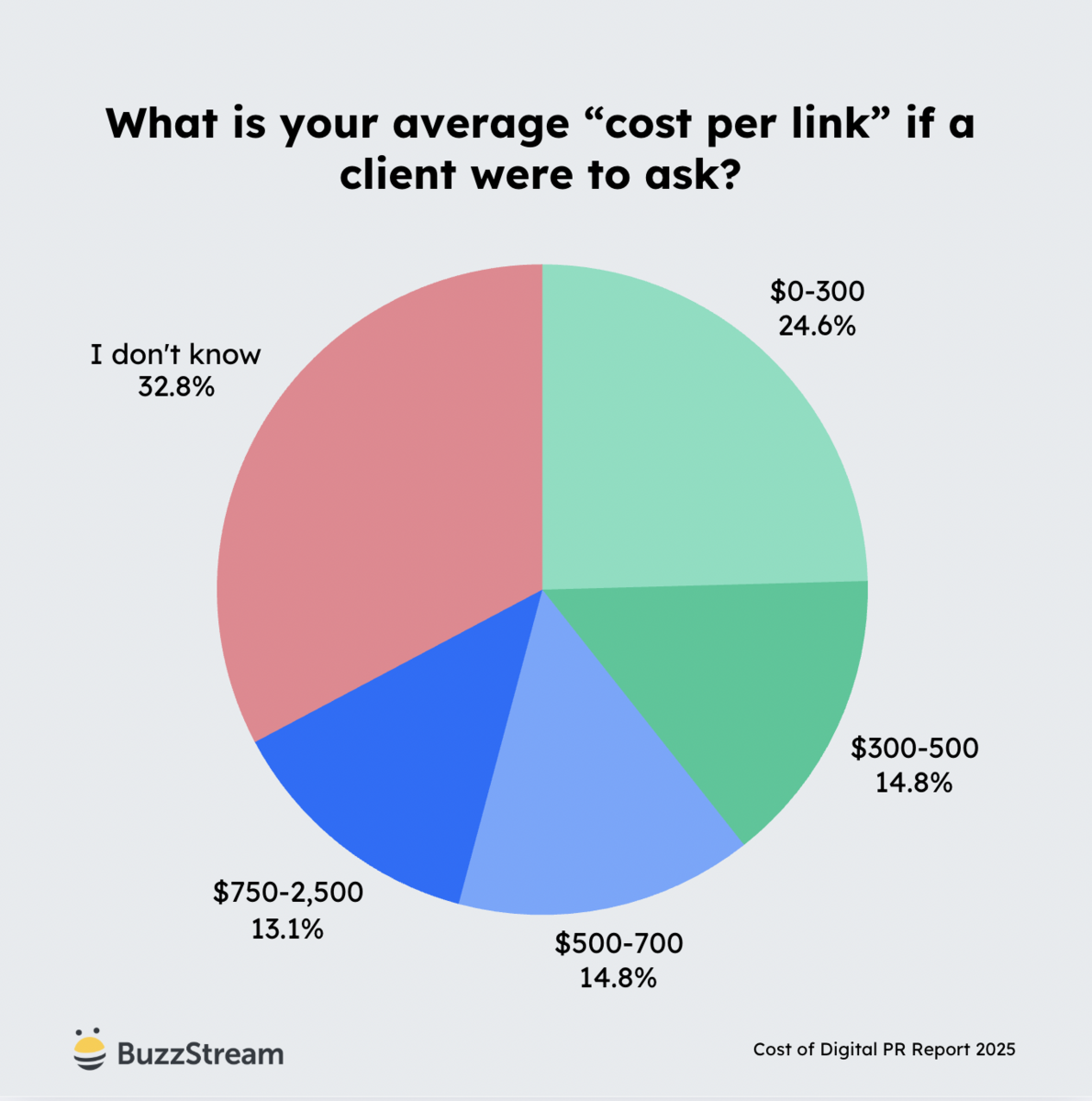
Based on our findings, about one in four have a cost per link below $300. Then, there is a spread of approximately 15% across the ranges: $300-$500, $500-$700, and the upper echelon of $750-$2,500.
Still, it is surprising that roughly one-third of respondents don’t know their cost per link. (This answer was much more prevalent from freelancers/consultants.)
This aligns with our State of Digital PR 2025 findings as well.
Chloe Osunsami, Head of Digital PR at Aira, added:
“I understand that cost per link is attractive for reporting to senior stakeholders, as PR value has been hard to quantify – and historically this was seen as one easy way to do so.
However, as digital PR moves further away from just looking at link volume and towards the quality and relevance of brand coverage as a lead metric, it will become more common for PRs not to know the cost per link.
This is something PRs and stakeholders will need to become more comfortable with, and instead, adapt to looking at correlations with broader (business-focused) lag metrics, or taking a blended search approach to reporting, to help justify budgets.”
Based on this, we can now examine the types of services and how they affect pricing.
Costs For Types of Digital PR Services
Costs vary depending on the services you receive.
In our study, we looked at four main service offerings that are closely associated with digital PR and how common they are amongst the agencies surveyed:
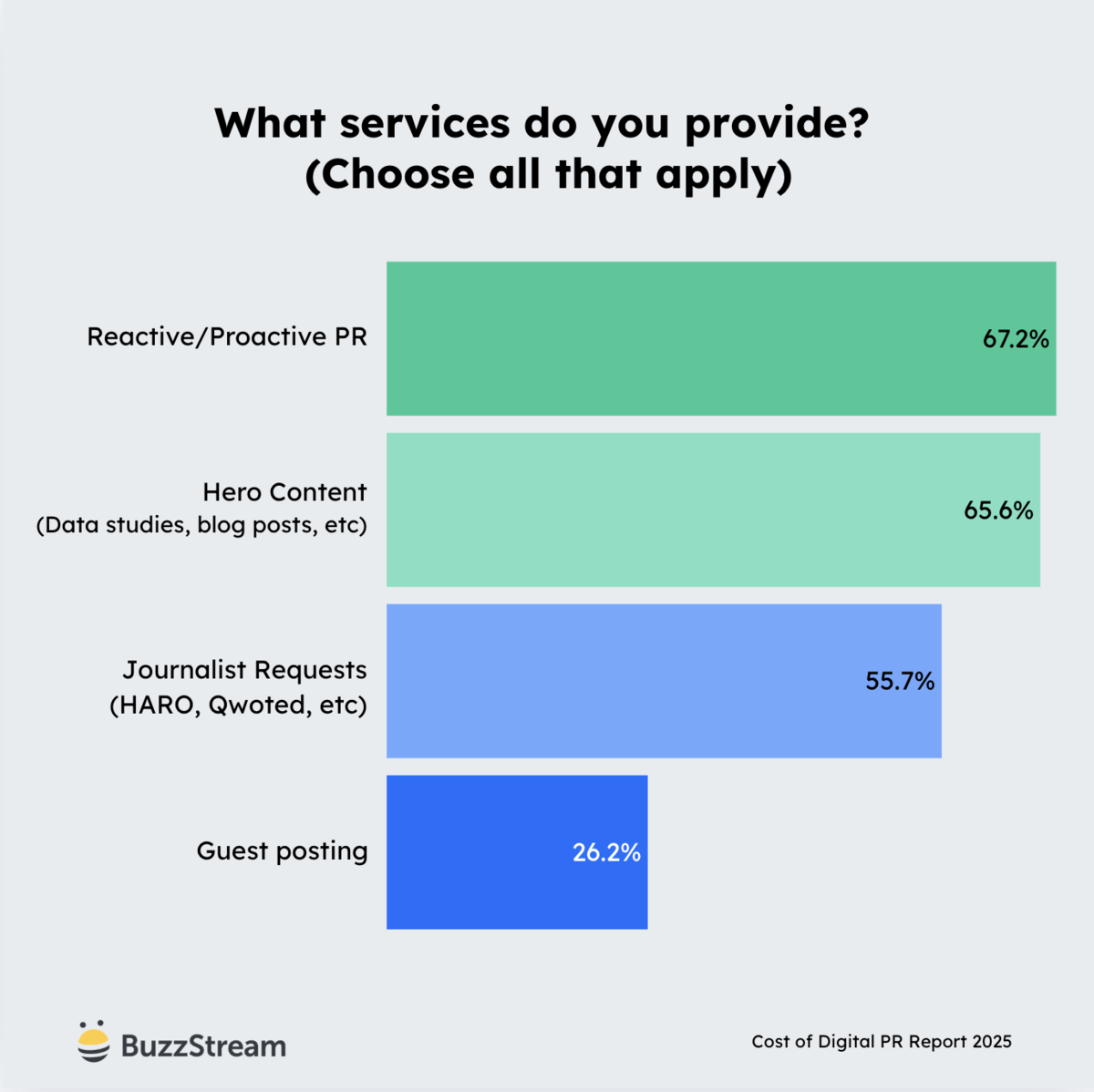
(Guest posting may be surprising to see on here, which I’ll get to later.)
When we grouped the costs by types of service, they broke down like this:
| Service Type | Estimated Average Cost per Link (USD) | Estimated Average Monthly Contract (USD) |
|---|---|---|
| Guest Posting | $150 | $2,500 |
| Journalist Requests | $400 | $4,000 |
| Reactive/Proactive PR | $625 | $6,000 |
| Hero Content | $800 | $8,000 |
(Note, these are technically category-weighted midpoints, not necessarily mathematical averages.)
As you can see, hero digital PR content, such as data studies or lengthy blog posts, tends to cost 3-4 times as much on average as other services.
This is not all that surprising, given the effort that goes into some of the larger hero content.
Journalist requests (such as monitoring and responding to HARO, SOS, or Qwoted requests) seem to be on the rise these days, and on average, they are among the lower-cost digital PR services.
If you’re unfamiliar with any of these types of services, we’ve outlined them all in our digital PR examples post.
Guest posting has the lowest cost per link, though, as our previous analysis showed, this may be undervaluing the service (by a lot). Based on our analysis of guest posting sites, the average cost of a guest post through a vendor is $1,459.06.
Next, let’s consider the average contract length.
Average Contract Length in Digital PR
Most contracts (about 75%) are more than 6 months long.
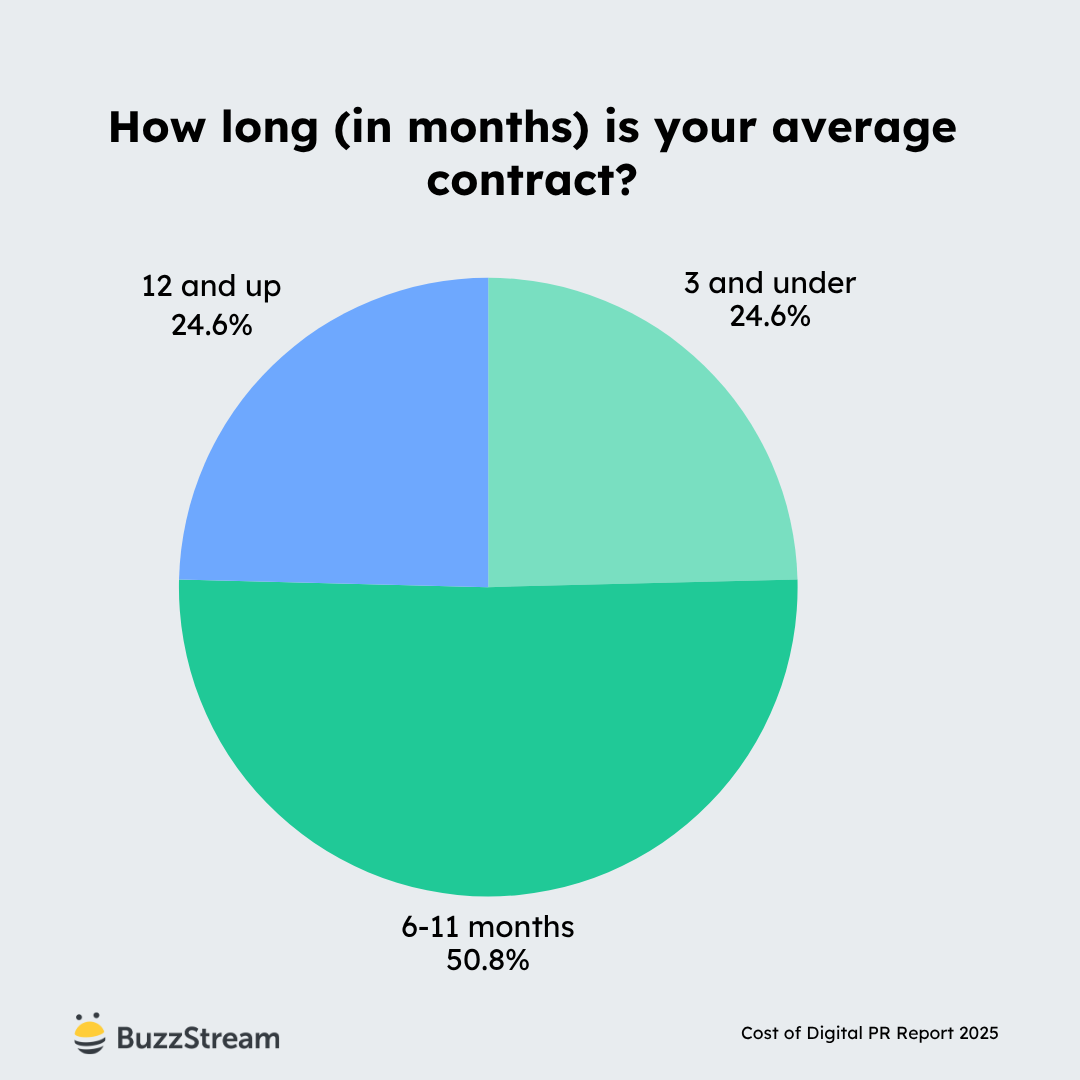
Just a quarter fell into the three-and-under bucket, and looking deeper, those are from freelancers and consultants.
Overall, the larger agencies demand more extended contracts.
When asking around, Matt Foster, Senior Digital PR Manager at Distinctly, told me:
“There’s often a balance that needs to be struck between giving Digital PR teams sufficient time to demonstrate impact on visibility, and marketing teams wanting to maintain budget flexibility. While most teams would (and should!) prioritise long-term partnerships, the 6-11 month contract length probably strikes this middle ground.
Anything below 3 months can be a red flag, in my experience. Such a short agreement doesn’t provide space for long-term strategic collaboration, and is in contrast to the goal of building brand authority and delivering sustained value across key services.”
Does Digital PR Guarantee Links?
Overall, about 50% of digital PR agencies guarantee links as part of their services.
This is a regular hot-button issue on LinkedIn.
That said, upon further investigation, this is heavily influenced by those offering guest posting services, which makes sense.
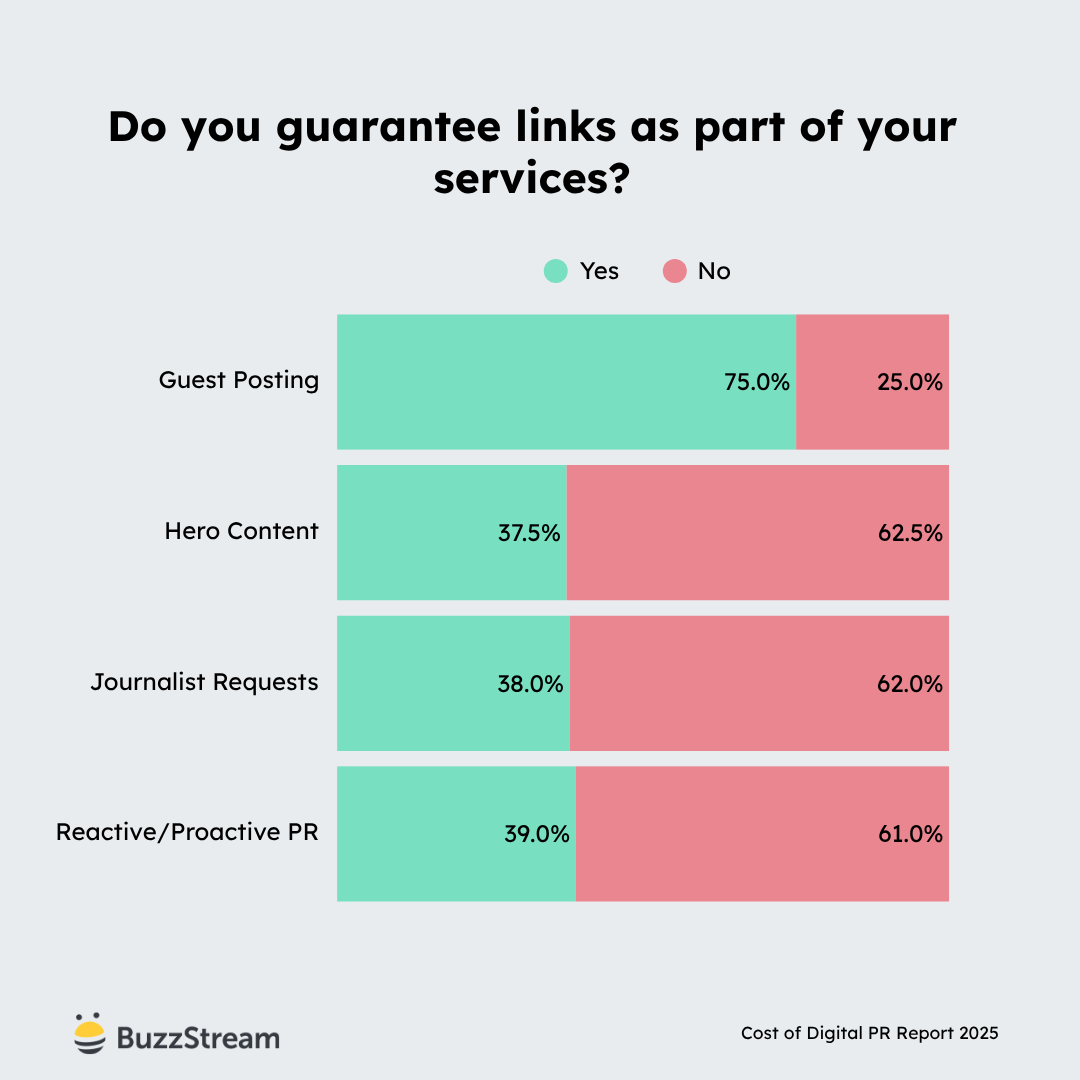
So, the takeaway, unsurprisingly, is that the more creative or earned the tactic is, the less guaranteed it is.
Now that we know the monthly contract size and cost per link, let’s step back a second and understand how brands are actually charging clients.
How Do Practioners Charge for Digital PR Services?
Our survey shows that about half of digital PR practitioners charge on a monthly retainer basis.
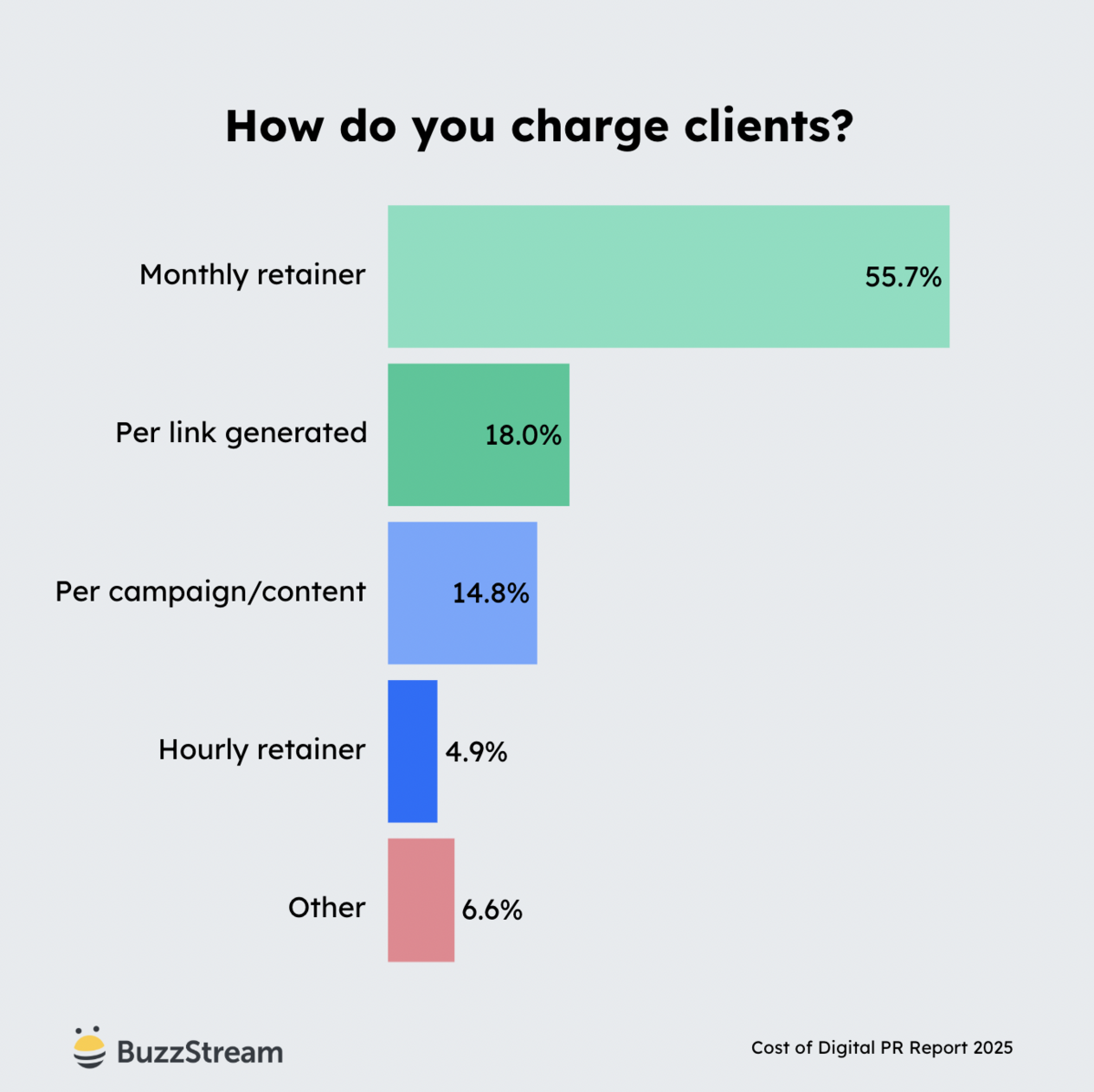
Digging into the data a bit more, we see that about 90% of agencies use the monthly retainer model.
Based on our data, the hero digital PR campaigns tend to command the highest monthly retainers.
Then, looking into the types of services, we can see that hero campaigns command the highest retainers:
| Service Type | Pricing Model | ||
|---|---|---|---|
| Hero Content | Retainer / Project | ||
| Reactive/Proactive PR | Retainer | ||
| Journalist Requests | Retainer / Project | ||
| Guest Posting | Per-link / Small Retainer |
Surprisingly, they also carry very high link guarantees of 62.5%
Tom Chivers, Digital PR Specialist at Sabot, says:
“While there are no guarantees when it comes to Digital PR (it is earned media after all) retainers are one of the best ways to achieve sustainable links over time.
“Project-based work might deliver a quick burst of links, but it’s often necessary for PRs to have a ‘bedding-in period’ where they figure out what works vs what doesn’t.
“A well-structured retainer gives both sides room to experiment and ultimately deliver more consistent results.”
What Outcomes Does Digital PR Charge For?
Most digital PRs charge for nofollow links (74%), while fewer charge for syndicated links (68%) and unlinked mentions (64%).
Years ago, I would never count unlinked mentions, social media links, or even syndicated links because there was less evidence that they impacted rankings.
These days, unlinked brand mentions do seem to play a role not only in Google’s algorithm (as per the Google Leak) but also in AI citations, as per our conversation with Louise Linehan of Ahrefs.
Here’s what our survey respondents say:
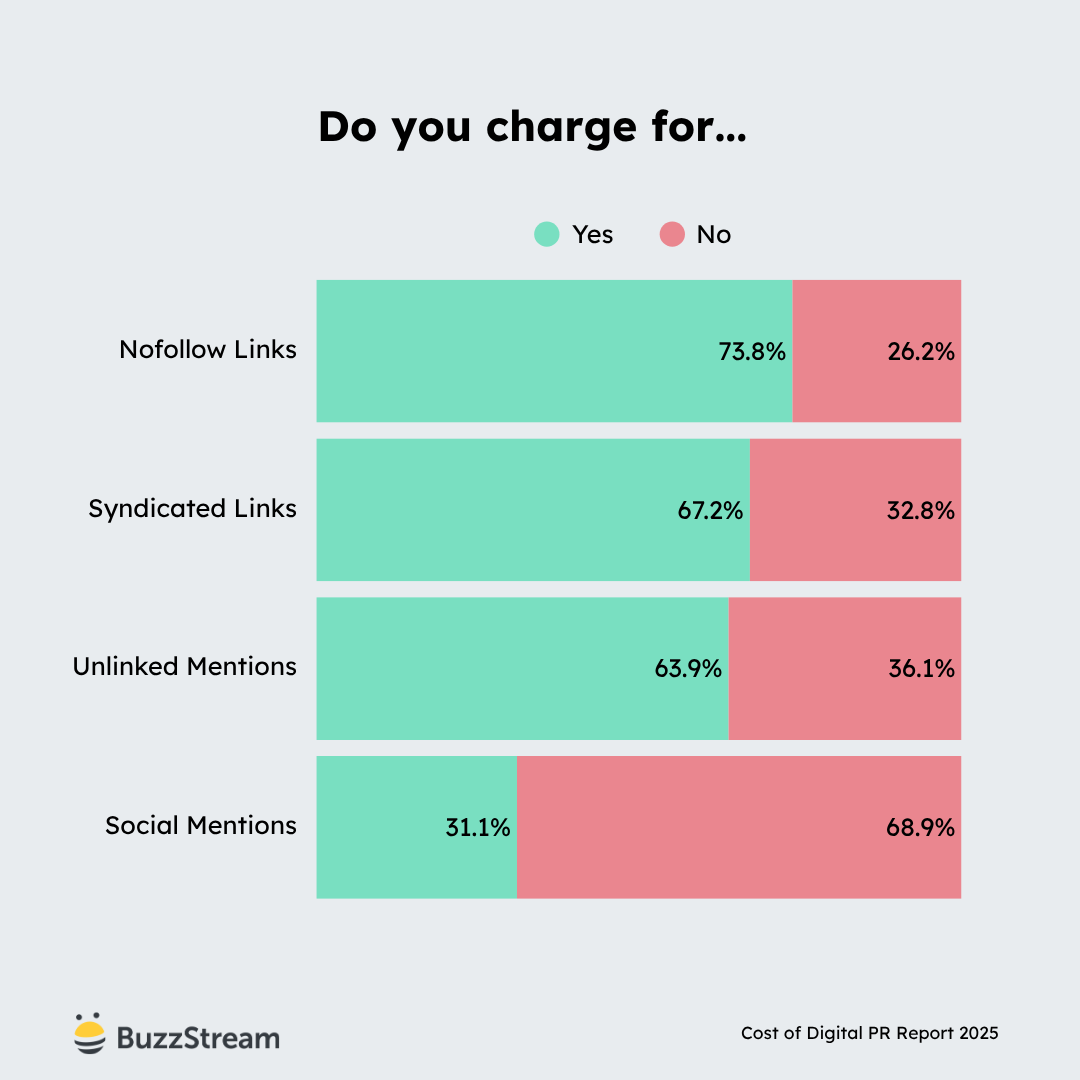
Social mentions are rarely monetized, which I’d expect to change in the near future, given the exposure of sites like Reddit to AI.
Digital PR Costs from Freelancers vs Agencies
Digital PR agencies charge about 50% more per month than freelancers/consultants.
| Work Type | Average Cost per Link (USD) | Average Monthly Contract (USD) |
|---|---|---|
| Agency | $663 | $6,357 |
| Freelancer | $416 | $4,200 |
This is unsurprising, as most agencies charge a premium for their depth of service, not to mention the additional people involved.
Agencies also have longer-term contracts.
| Contract Length Bucket | Agencies | Freelancers / Consultants |
|---|---|---|
| Short-term (≤ 3 months) | 12% | 37% |
| Mid-term (6–11 months) | 53% | 43% |
| Long-term (12+ months) | 35% | 20% |
In general, we can see that agencies tend to offer more of the larger, time-intensive digital PR services, like hero content and reactive PR.
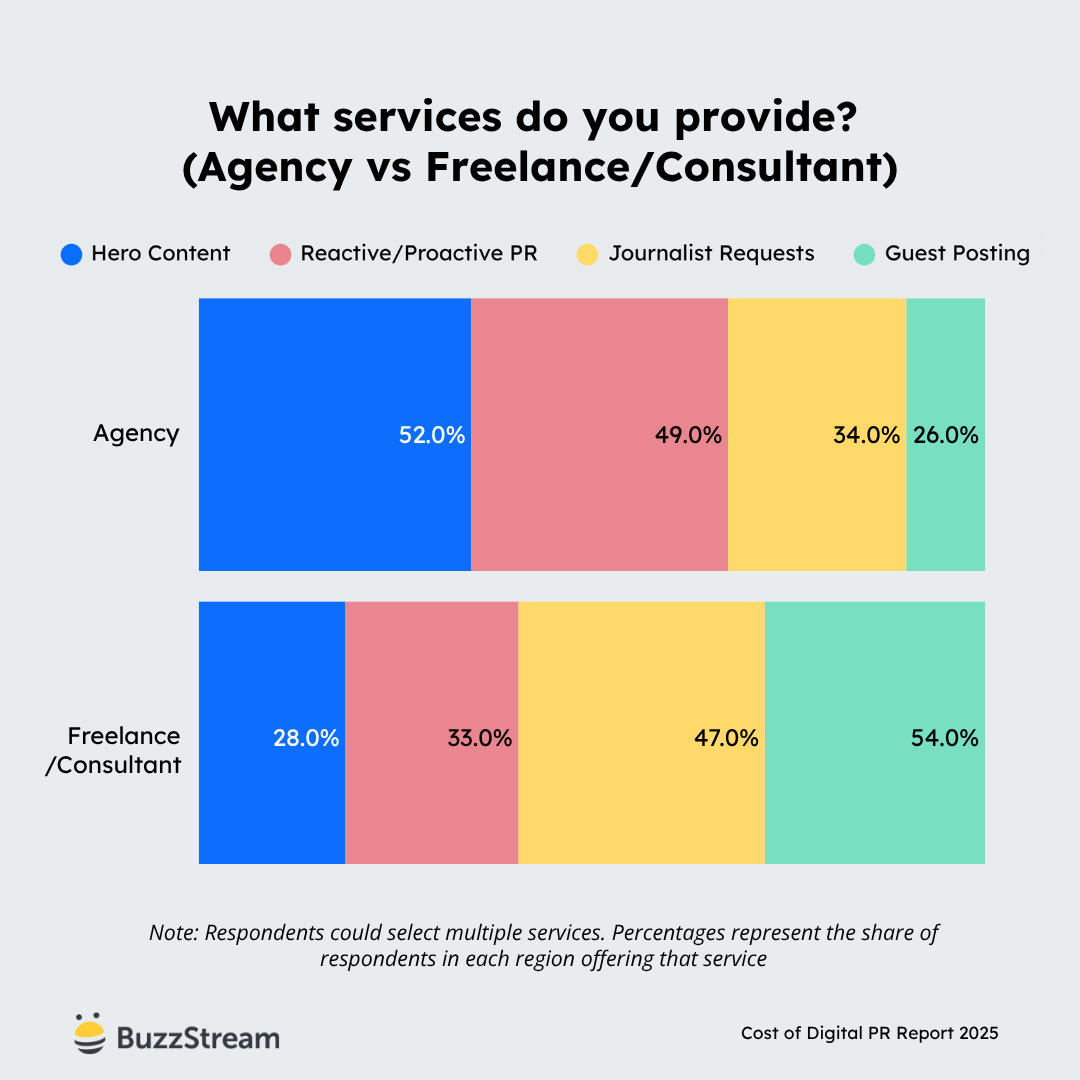
Freelancers, meanwhile, lean heavily on journalist requests and guest posting, where deliverables are faster, more direct, and easier to quantify.
Next, let’s look to see if the geographic differences play into this:
Geographical Differences (U.S. vs UK vs World) in Digital PR Costs
We see that the U.S. actually has the highest digital PR contract sizes:
| Country | Average Cost per Link (USD) | Average Monthly Contract (USD) |
|---|---|---|
| US | $350 | $6,154 |
| Other | $461 | $5,357 |
| UK | $818 | $5,227 |
But they also have the lowest CPL. Most US respondents placed their CPL in the $0-$500 range, whereas most UK respondents placed theirs in the $500+ range.
One reason for this might be the services that they offer, so let’s look here:
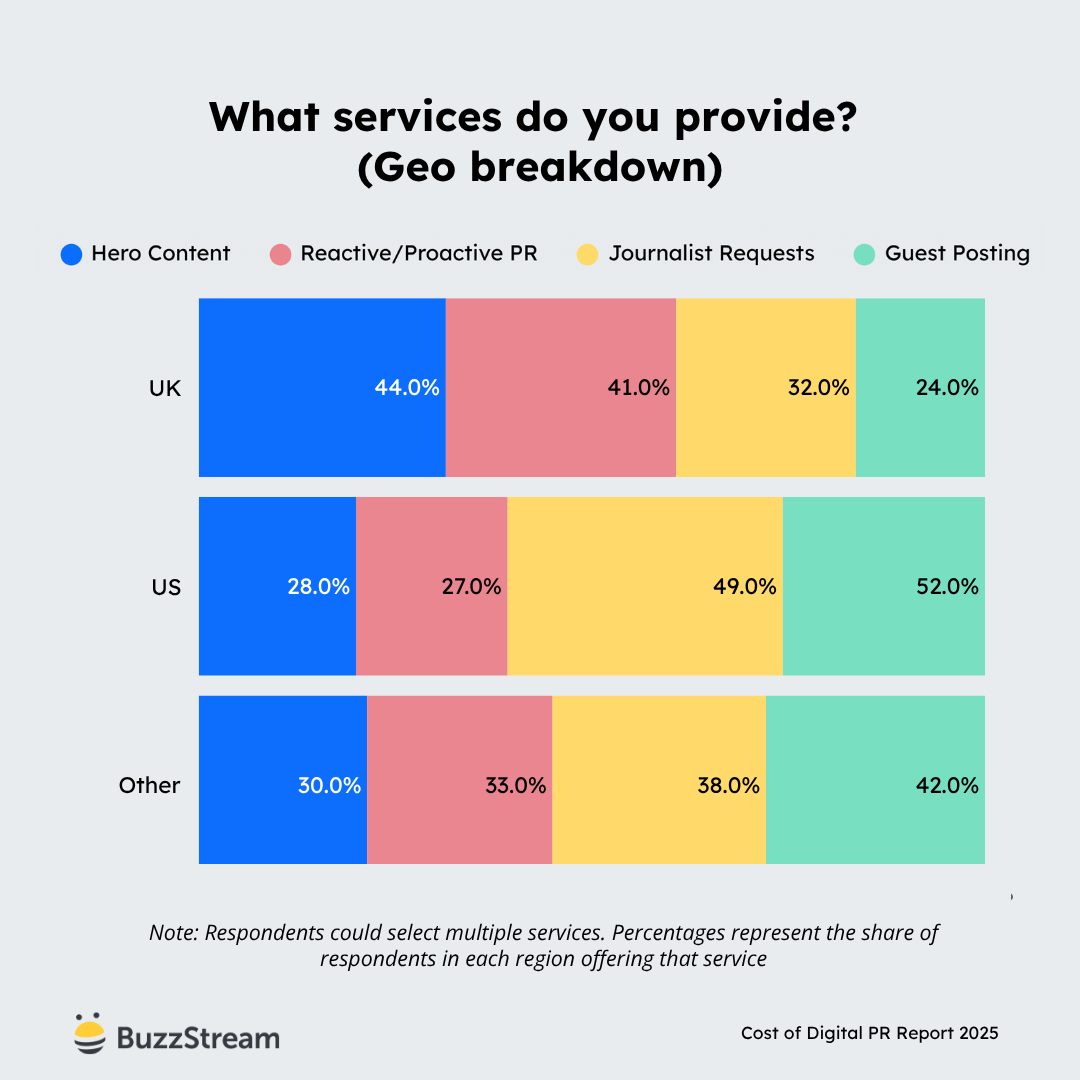
As we can see, the UK and other regions typically offer higher-priced services more frequently (hero content, reactive/proactive PR), whereas the US skews more toward journalist requests and guest posting.
This is also reflected in the link guarantees by region:
| Region | Guarantees Links |
|---|---|
| US | 61% |
| UK | 43% |
| Other | 48% |
I’ve tried to answer that UK vs US question a lot over the years. I reached out to Domenica D’Ottavio, Director of PR at Journey Further, which is another agency that spends a lot of time in both markets.
She told me:
“Working across both the UK and the US has shown me that you can’t copy-paste a PR strategy across the Atlantic.
The UK favors creativity and speed. One big national idea can travel far and gain wide coverage.
In the US, success depends on precision: vertical targeting, localized data (often city-specific), and relationships built over time. It takes longer to land coverage, but once trust is established, journalists tend to come back.
Anecdotally, UK clients can be braver and more open to creative risks, while US clients, typically larger brands, operate within more complex internal approval structures that can slow things down.”
Where Digital PR Pricing Is Heading
Right now, there are a few reasons costs may rise.
- Journalists are being laid off
- Publisher site traffic is dropping as people move to alternative platforms for their news (like social, Youtube, and AI)
At the same time, there is strong evidence that getting mentioned in high-quality news sites can increase your exposure in AI citations (which is on everyone’s mind).
So, more agencies and brands are flocking to digital PR.
Ultimately, there is much more competition for far fewer journalists. This means that agencies that once saw hundreds of links, are seeing lower numbers.
So, the value of a link is at an all-time high.
James Brockbank, Managing Director, Digitaloft, told me:
“Digital PR costs are, without a doubt, headed higher; at least digital PR that drives an actual impact on real business metrics and commercial goals is.
Links and mentions have become a commodity to some extent, but there’s lots of providers out there offering cheap services that have absolutely no impact on the metrics that actually matter to a business.
People might think they want links and mentions, but they’re just a means to an end. What they actually want is growth in revenue (or the things that roll up to that, like leads).
Commoditised links and mentions that have no impact have a limited lifespan; businesses have been expecting more for quite some time now. And these services won’t be around long-term.
The core of this is that there’s only a small supply of service providers who truly get how to use digital PR to drive a commercial impact; and they’ll be in greater demand than ever, with the cost of these headed higher.”
The flipside, of course, is that costs will decrease because of AI.
Tools built with AI promise reduced costs for agencies and brands, allowing them to automate or assist in time-consuming tasks.
But there are both innovative and dangerous ways to use AI.
ListIQ is one of those innovative tools that can help save time when building media lists, for instance. It speeds up a manual process while still allowing oversight.
It becomes dangerous when AI tools take too much of the process out of the professional’s hands in an effort to cut costs.
These have recently drawn the ire of digital PRs and journalists alike online.
So, the future direction of digital PR costs depends on many factors. The best you can do is stay keyed into the trends.


